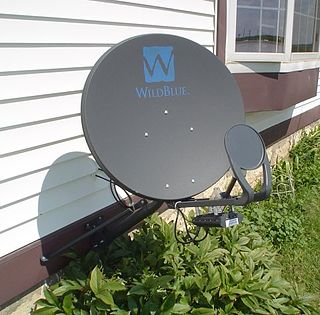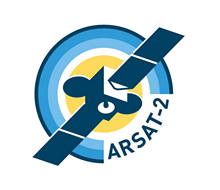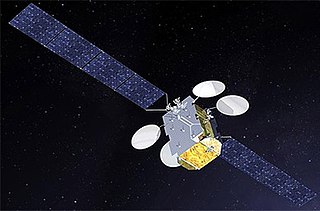
The Guiana Space Centre, also called Europe's Spaceport, is a European spaceport to the northwest of Kourou in French Guiana, a region of France in South America. Kourou is located approximately 310 mi (500 km) north of the equator at a latitude of 5°. In operation since 1968, it is a suitable location for a spaceport because of its equatorial location and open sea to the east.

Satellite Internet access is Internet access provided through communication satellites; if it can sustain high speeds, it is termed satellite broadband. Modern consumer grade satellite Internet service is typically provided to individual users through geostationary satellites that can offer relatively high data speeds, with newer satellites using the Ku band to achieve downstream data speeds up to 506 Mbit/s. In addition, new satellite internet constellations are being developed in low-earth orbit to enable low-latency internet access from space.
Hispasat is the operating company for a number of Spanish communications satellites that cover the Americas, Europe and North Africa from orbital positions 30.0° West and 61.0° West. It was formed in 1989 and its activities include provision of communication services in the commercial and government sectors. Hispasat's fleet of satellites broadcast more than 1250 television channels and radio stations to more than 30 million homes, as well as providing services such as broadband to mobile telephones and landlines.
This is a list of the satellites operated by Optus, an Australian telecommunications company. The satellite communications facility is located at Belrose on Sydney's Northern Beaches. Optus' satellites are divided into 4 classes A, B, C and D. As of April 2014 it owns and operates Optus B3, Optus C1, Optus D1, Optus D2 and Optus D3. Optus A1, Optus A2, Optus A3 and Optus B1 satellites have been retired. Optus has the largest network of satellites in Australia and New Zealand.

The Arab Satellite Communications Organization is a communications satellite operator in the Arab World, headquartered in the city of Riyadh, Saudi Arabia. Arabsat was created to deliver satellite-based, public and private telecommunications services to the Arab States, in accordance with International Standards. With 21 member countries, the organization plays a vital role of enhancing communications in the Arab World.

ELA-3, is a launch pad and associated facilities at the Centre Spatial Guyanais in French Guiana. ELA-3 was operated by Arianespace as part of the expendable launch system for Ariane 5 launch vehicles. As of July 2023, 117 launches have been carried out from it, the first of which occurred on 4 June 1996. The final launch occurred on 5 July 2023.
The Broadcasting Satellite System Corporation (B-SAT) is a Japanese corporation established in April 1993 to procure, manage and lease transponders on communications satellites. Its largest stockholder, owning 49.9%, is NHK, the Japan Broadcasting Corporation. In 1994, it was ranked by Space News as the world's 19th largest fixed satellite operator.

The National Broadband Network (NBN) is an Australian national wholesale open-access data network. It includes wired and radio communication components rolled out and operated by NBN Co, a government-owned corporation. Internet service providers, known under NBN as retail service providers or RSPs, contract with NBN to access the data network and sell fixed Internet access to end users.

ARSAT-1 is a geostationary communications satellite operated by AR-SAT and built by the Argentine company INVAP. ARSAT-1 was launched into orbit on October 16, 2014, from French Guiana alongside Intelsat-30 satellite using an Ariane 5 rocket. It is expected to be located at 72° West longitude geostationary slot. ARSAT-1 is the first geostationary satellite built in Latin America. Total cost of the satellite is 270 million US dollars.

ARSAT-2 is a geostationary communications satellite operated by ARSAT and built by the Argentine company INVAP. It was launched from French Guiana alongside Sky Muster satellite using an Ariane 5ECA rocket on September 30, 2015 at 20:30hs UTC, becoming the 400th satellite to be launched by Arianespace. It is licensed to be located at 81° West longitude geostationary slot. ARSAT-2 is the second geostationary satellite built in Argentina, after ARSAT-1. Structurally and mechanically it is a copy of the ARSAT-1, the only difference being the payload and thus it has different antenna configuration.
BSAT-4a is a geostationary communications satellite ordered by Broadcasting Satellite System Corporation (BSAT) and designed and manufactured by SSL on the SSL 1300 platform, to be stationed on the 110.0° East orbital slot for direct television broadcasting of 4K and 8K Ultra HD resolutions. It was launched on 29 September 2017.
JCSAT-15 is a communications satellite designed and manufactured for SKY Perfect JSAT Group by SSL on the SSL 1300 platform. It has a launch weight of 3,400 kg (7,500 lb), a power production capacity of 10 kW and a 15-year design life. Its payload is composed of Ku band and Ka band transponders.
The JSAT constellation is a communication and broadcasting satellite constellation formerly operated by JSAT Corporation and currently by SKY Perfect JSAT Group. It has become the most important commercial constellation in Japan, and fifth in the world. It has practically amalgamated all private satellite operators in Japan, with only B-SAT left as a local competitor.

GSAT-18 is an Indian communications satellite. Built by ISRO and operated by INSAT, it carries 24 C-band, 12 extended C-band, and 12 Ku-band transponders.
The National Broadband Network had its origins in 2006 when the Federal Labor Opposition led by Kim Beazley committed the Australian Labor Party, if elected to government to a 'super-fast' national broadband network. Initial attempts to engage key businesses in Australian telecommunications in planning and development; and implementation and operation failed with NBN Co being set up in 2010 to have carriage of the 'largest infrastructure' project in Australia's history.
Intelsat 702 is a geostationary communication satellite that was built by Space Systems/Loral (SSL). It is located in the orbital position of 32.9 degrees east longitude and it is currently in an inclined orbit. The satellite is owned by Intelsat. The satellite was based on the Loral FS-1300 platform and its estimated useful life was 15 years.

Eutelsat Konnect is a geostationary communications satellite operated by Eutelsat. The satellite was designed and manufactured by Thales Alenia Space on the Spacebus NEO 100 platform, and was launched on 16 January 2020 on an Ariane 5 ECA. The satellite provides broadband internet and communications coverage to Europe and Sub-Saharan Africa.








